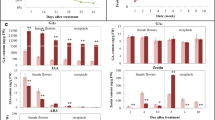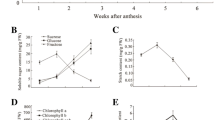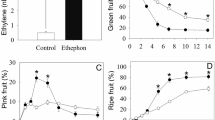Key message
The regulatory landscape of ethephon-accelerated fig ripening is revealed; flowers and receptacles exhibit opposite responses in anthocyanin accumulation; PG, PL and EXP are suggested key genes in fig softening.
Abstract
Ethephon is used to accelerate fig-fruit ripening for improvement of harvesting efficiency, but the underlying molecular mechanism is still unclear. To elucidate the detailed biological mechanism of ethylene-accelerated fig ripening, fruit in phase II (the lag phase on the double sigmoid growth curve) were treated with ethephon, and reached commercial ripeness 6 days earlier than the nontreated controls. Transcriptomes of flowers and the surrounding receptacles—which together make up the pseudocarp in fig fruit—were analyzed. There were 5189, 5818 and 2563 differentially expressed genes (DEGs) 2, 4 and 6 days after treatment (DAT) in treated compared to control fruit, screened by p-adjust < 0.05 and |log2(fold change) |≥ 2. The DEGs were significantly enriched in plant hormone metabolism and signal transduction, cell-wall modification, sugar accumulation and anthocyanin accumulation pathways. DEGs in the first three pathway categories demonstrated an overall similar expression change in flowers and receptacles, whereas DEGs in anthocyanin pigmentation revealed divergent transcript abundance. Specifically, in both flowers and receptacles, ethephon significantly upregulated 1-aminocyclopropane-1-carboxylate oxidase and downregulated most of the ethylene-response factor genes; polygalacturonase, pectate lyase and expansin were mainly upregulated; two acid beta-fructofuranosidases were upregulated. However, structural genes in the anthocyanin-synthesis pathway were mainly downregulated in female flowers 2 and 4 DAT, whereas they were upregulated in the receptacles. Our study reveals the regulatory landscape of the two tissues of fig fruit in ethylene-induced ripening; the differentially expressed pathways and genes provide valuable resources for the mining of target genes for crucial biological and commercial trait improvement.










Similar content being viewed by others
Data Availability
The RNA-Seq data have been deposited in NCBI (SRA accession: PRJNA606407).
References
Alexander L, Grierson D (2002) Ethylene biosynthesis and action in tomato: a model for climacteric fruit ripening. J Exp Bot 53(377):2039–2055. https://doi.org/10.1093/jxb/erf072
Ban T, Kugishima M, Ogata T, Shiozaki S, Horiuchi S, Ueda H (2007) Effect of ethephon (2-chloroethylphosphonic acid) on the fruit ripening characters of rabbiteye blueberry. Sci Hortic 112(3):278–281. https://doi.org/10.1016/j.scienta.2006.12.027
Barba-Espín G, Glied S, Crocoll C, Dzhanfezova T, Joernsgaard B, Okkels F, Lutken H, Muller R (2017) Foliar-applied ethephon enhances the content of anthocyanin of black carrot roots (Daucus carota ssp. sativus var atrorubens Alef.). BMC Plant Biol 17(1):70. https://doi.org/10.1186/s12870-017-1021-7
Bashline L, Lei L, Li S, Gu Y (2014) Cell wall, cytoskeleton, and cell expansion in higher plants. Mol Plant 7(4):586–600. https://doi.org/10.1093/mp/ssu018
Bleecker AB, Kende H (2000) Ethylene: a gaseous signal molecule in plants. Annu Rev Cell Dev Biol 16(1):1–18. https://doi.org/10.1146/annurev.cellbio.16.1.1
Brummell DA, Harpster MH, Civello PM, Palys JM, Bennett AB, Dunsmuir P (1999) Modification of expansin protein abundance in tomato fruit alters softening and cell wall polymer metabolism during ripening. Plant Cell 11(11):2203–2216. https://doi.org/10.2307/3871019
Cao L, Xu X, Chen S, Ma H (2016) Cloning and expression analysis of Ficus carica anthocyanidin synthase 1 gene. Sci Hortic 211:369–375. https://doi.org/10.1016/j.scienta.2016.09.015
Celikel FG, Kaynas K, Özelkök S, Ertan Ü (1996) Effects of ethephon on fruit development and ripening of the fig (Ficus carica L.) Variety" Bursa Siyahi". Acta Hort 441:145–152. https://doi.org/10.17660/actahortic.1997.441.19
Chai P, Dong S, Chai L, Chen S, Flaishman M, Ma H (2019) Cytokinin-induced parthenocarpy of San Pedro type fig (Ficus carica L.) main crop: explained by phytohormone assay and transcriptomic network comparison. Plant Mol Biol 99(4–5):329–346. https://doi.org/10.1007/s11103-019-00820-2
Chai L, Li Y, Chen S, Perl A, Zhao F, Ma H (2014) RNA sequencing reveals high resolution expression change of major plant hormone pathway genes after young seedless grape berries treated with gibberellin. Plant Sci 229:215–224. https://doi.org/10.1016/j.plantsci.2014.09.010
Chai L, Wang Z, Chai P, Chen S, Ma H (2017) Transcriptome analysis of San Pedro-type fig (Ficus carica L.) parthenocarpic breba and non-parthenocarpic main crop reveals divergent phytohormone-related gene expression. Tree Genet Genomes 13(4):83. https://doi.org/10.1007/s11295-017-1166-4
Cheng Y, Liu L, Yuan C, Guan J (2016) Molecular characterization of ethylene-regulated anthocyanin biosynthesis in plums during fruit ripening. Plant Mol Biol Rep 34(4):777–785. https://doi.org/10.1007/s11105-015-0963-x
Conesa A, Madrigal P, Tarazona S, Gomez-Cabrero D, Cervera A, McPherson A, Szczesniak MW, Gaffney DJ, Elo LL, Zhang X, Mortazavi A (2016) A survey of best practices for RNA-seq data analysis. Genome Biol 17(1):13. https://doi.org/10.1186/s13059-016-0881-8
Crisosto CH, Bremer V, Ferguson L, Crisosto GM (2010) Evaluating quality attributes of four fresh fig (Ficus carica L.) cultivars harvested at two maturity stages. HortScience 45(4): 707–710. https://doi.org/https://doi.org/10.21273/hortsci.45.4.707
Cui Y, Wang Z, Chen S, Vainstein A, Ma H (2019) Proteome and transcriptome analyses reveal key molecular differences between quality parameters of commercial-ripe and tree-ripe fig (Ficus carica L.). BMC Plant Biol 19(1):146. https://doi.org/10.1186/s12870-019-1742-x
Flaishman MA, Rodov V, Stover E (2008) The fig: botany, horticulture, and breeding. Hortic Rev 34:113–196. https://doi.org/10.1002/9780470380147.ch2
Freiman ZE, Rodov V, Yablovitz Z, Horev B, Flaishman MA (2012) Preharvest application of 1-methylcyclopropene inhibits ripening and improves keeping quality of ‘Brown Turkey’figs (Ficus carica L.). Sci Hortic 138:266–272. https://doi.org/10.1016/j.scienta.2013.05.035
Freiman ZE, Rosianskey Y, Dasmohapatra R, Kamara I, Flaishman MA (2015) The ambiguous ripening nature of the fig (Ficus carica L.) fruit: a gene-expression study of potential ripening regulators and ethylene-related genes. J Exp Bot 66(11):3309–3324. https://doi.org/10.1093/jxb/erv140
Fu CC, Han YC, Qi XY, Shan W, Chen JY, Lu WJ, Kuang JF (2016) Papaya CpERF9 acts as a transcriptional repressor of cell-wall-modifying genes CpPME1/2 and CpPG5 involved in fruit ripening. Plant Cell Rep 35(11):2341–2352. https://doi.org/10.1007/s00299-016-2038-3
Fukuda H (2015) Plant cell wall patterning and cell shape. Wiley Blackwell, Hoboken. https://doi.org/10.1002/9781118647363
Han YC, Kuang JF, Chen JY, Liu XC, Xiao YY, Fu CC, Wang JN, Wu KQ, Lu WJ (2016) Banana transcription factor MaERF11 recruits histone deacetylase MaHDA1 and represses the expression of MaACO1 and expansins during fruit ripening. Plant Physiol 171(2):1070–1084. https://doi.org/10.1104/pp.16.00301
Hirai M (1982) Accelerated sugar accumulation and ripening of loquat fruit by exogenously applied ethylene. J Jpn Soc Hortic Sci 51(2):159–164. https://doi.org/10.2503/jjshs.51.159
Hiratsu K, Ohta M, Matsui K, Ohme-Takagi M (2002) The SUPERMAN protein is an active repressor whose carboxy-terminal repression domain is required for the development of normal flowers. FEBS Lett 514(2–3):351–354. https://doi.org/10.1016/s0014-5793(02)02435-3
Human MA (2010) Effect of shading and ethephon on the anthocyanin composition of ‘Crimson Seedless’ (Vitis vinifera L.) Doctoral dissertation, Stellenbosch: University of Stellenbosch
Jeong SW, Das PK, Jeoung SC, Song JY, Lee HK, Kim YK, Kim WJ, Park YI, Yoo SD, Choi SD, Choi G, Park YI (2010) Ethylene suppression of sugar-induced anthocyanin pigmentation in Arabidopsis. Plant Physiol 154(3):1514–1531. https://doi.org/10.1104/pp.110.161869
Jiang F, Lopez A, Jeon S, de Freitas ST, Yu Q, Wu Z, Labavitch JM, Tian SK, Powell ALT, Mitcham E (2019) Disassembly of the fruit cell wall by the ripening-associated polygalacturonase and expansin influences tomato cracking. Hortic Res 6(1):1–15. https://doi.org/10.1038/s41438-018-0105-3
Kaur R, Kaur N, Singh H (2019) Pericarp and pedicel anatomy in relation to fruit cracking in lemon (Citrus limon L Burm.). Sci Hortic 246:462–468. https://doi.org/10.1016/j.scienta.2018.11.040
Klee HJ, Giovannoni JJ (2011) Genetics and control of tomato fruit ripening and quality attributes. Annu Rev Genet 45(1):41–59. https://doi.org/10.1146/annurev-genet-110410-132507
Li T, Xu Y, Zhang L, Ji Y, Tan D, Yuan H, Wang A (2017) The jasmonate-activated transcription factor MdMYC2 regulates ethylene response factor and ethylene biosynthetic genes to promote ethylene biosynthesis during apple fruit ripening. Plant Cell 29(6):1316–1334. https://doi.org/10.1105/tpc.17.00349
Livak KJ, Schmittgen TD (2001) Analysis of relative gene expression data using real-time quantitative PCR and the 2−ΔΔCT method. Methods 25(4):402–408. https://doi.org/10.1006/meth.2001.1262
Lama K, Yadav S, Rosianski Y, Shaya F, Lichter A, Chai L, Dahan Y, Freiman Z, Peer R, Flaishman MA (2018) The distinct ripening processes in the reproductive and non-reproductive parts of the fig syconium are driven by ABA. J Exp Bot 70(1):115–131. https://doi.org/10.1093/jxb/ery333
Li C, Shen Y (2016) Relationship between ABA and ethylene content and fruit ripening during fig fruit development. J China Agric Univ 21(11):51–56. https://doi.org/10.11841/j.isn.1007-4333.2016.11.07
Li S, Chen K, Grierson D (2019) A critical evaluation of the role of ethylene and MADS transcription factors in the network controlling fleshy fruit ripening. New Phytol 221(4):1724–1741. https://doi.org/10.1111/nph.15545
Li T, Jiang Z, Zhan L, Tan D, Wei Y, Yuan H, Li TL, Wang AD (2016) Apple (Malus domestica) MdERF2 negatively affects ethylene biosynthesis during fruit ripening by suppressing MdACS1 transcription. Plant J 88(5):735–748. https://doi.org/10.1111/tpj.13289
Li Y, Lu H, Cheng Q, Li R, He S, Li B (2016) Changes of reactive oxygen species and scavenging enzymes of persimmon fruit treated with CO2 deastringency and the effect of hydroxyl radicals on breakdown of cell wall polysaccharides in vitro. Sci Hortic 199:81–87. https://doi.org/10.1016/j.scienta.2015.12.040
Liu MY, Song CZ, Chi M, Wang TM, Zuo LL, Li XL, Zhang ZW, Xi ZM (2016) The effects of light and ethylene and their interaction on the regulation of proanthocyanidin and anthocyanin synthesis in the skins of Vitis vinifera berries. Plant Growth Regul 79(3):377–390. https://doi.org/10.1007/s10725-015-0141-z
Marei N, Crane JC (1971) Growth and respiratory response of fig (Ficus carica L. cv. Mission) fruits to ethylene. Plant Physiol 48(3):249–254. https://doi.org/10.1104/pp.48.3.249
Marei N, Romani R (1971) Ethylene-stimulated synthesis of ribosomes, ribonucleic acid, and protein in developing fig fruits. Plant Physiol 48(6):806. https://doi.org/10.1104/pp.48.6.806
Marowa P, Ding A, Kong Y (2016) Expansins: roles in plant growth and potential applications in crop improvement. Plant Cell Rep 35(5):949–965. https://doi.org/10.1007/s00299-016-1948-4
Márquez-López RE, Quintana-Escobar AO, Loyola-Vargas VM (2019) Cytokinins, the Cinderella of plant growth regulators. Phytochem Rev 18(6):1387–1408. https://doi.org/10.1007/s11101-019-09656-6
Mori K, Shirasawa K, Nogata H, Hirata C, Tashiro K, Habu T, Kim S, Himeno S, Kuhara S, Ikegami H (2017) Identification of RAN1 orthologue associated with sex determination through whole genome sequencing analysis in fig (Ficus carica L.). Sci Rep 7:41124. https://doi.org/10.1038/srep41124
Ni J, Zhao Y, Tao R, Yin L, Gao L, Strid Å, Qian M, Li J, Li Y, Shen J, Teng Y, Bai S (2020) Ethylene mediates the branching of the jasmonate-induced flavonoid biosynthesis pathway by suppressing anthocyanin biosynthesis in red Chinese pear fruits. Plant Biotechnol J 18(5):1223–1240. https://doi.org/10.1111/pbi.13287
Ohme-Takagi M, Shinshi H (1995) Ethylene-inducible DNA binding proteins that interact with an ethylene-responsive element. Plant Cell 7(2):173–182. https://doi.org/10.2307/3869993
Owino WO, Manabe Y, Mathooko FM, Kubo Y, Inaba A (2006) Regulatory mechanisms of ethylene biosynthesis in response to various stimuli during maturation and ripening in fig fruit (Ficus carica L.). Plant Physiol Biochem 44(5–6):335–342. https://doi.org/10.1016/j.plaphy.2006.03.009
Posé S, Kirby AR, Paniagua C, Waldron KW, Morris VJ, Quesada MA, Mercado JA (2015) The nanostructural characterization of strawberry pectins in pectate lyase or polygalacturonase silenced fruits elucidates their role in softening. Carbohyd Polym 132:134–145. https://doi.org/10.1016/j.carbpol.2015.06.018
Puech AA, Rebeiz CA, Crane JC (1976) Pigment changes associated with application of ethephon ((2-chloroethyl) phosphonic acid) to fig (Ficus carica L.) fruits. Plant Physiol 57(4):504–509. https://doi.org/10.1104/pp.57.4.504
Rosianski Y, Doron-Faigenboim A, Freiman ZE, Lama K, Milo-Cochavi S, Dahan Y, Kerem Z, Flaishman MA (2016) Tissue-specific transcriptome and hormonal regulation of pollinated and parthenocarpic fig (Ficus carica L.) fruit suggest that fruit ripening is coordinated by the reproductive part of the syconium. Front Plant Sci 7:1696. https://doi.org/10.3389/fpls.2016.01696
Saw NMMT, Riedel H, Cai Z, Kütük O, Smetanska I (2012) Stimulation of anthocyanin synthesis in grape (Vitis vinifera) cell cultures by pulsed electric fields and ethephon. Plant Cell Tissue Organ Culture (PCTOC) 108(1):47–54. https://doi.org/10.1007/s11240-011-0010-z
Singh J, Bal JS, Singh S, Mirza A (2018) Assessment of chemicals and growth regulators on fruit ripening and quality: a review. Plant Arch 18(2):1215–1222
Usai G, Mascagni F, Giordani T, Vangelisti A, Bosi E, Zuccolo A, Ceccarelli M, King R, Hassani-Pak K, Zambrano LS, Cavallini A, Natali L (2019) Epigenetic patterns within the haplotype phased fig (Ficus carica L.) genome. Plant J 102(3):600–614. https://doi.org/10.1111/tpj.14635
Wang R, Angenent GC, Seymour G, de Maagd RA (2020) Revisiting the role of master regulators in tomato ripening. Trends Plant Sci 25(3):291–301. https://doi.org/10.1016/j.tplants.2019.11.005
Wang X, Zeng W, Ding Y, Wang Y, Niu L, Yao JL, Pan L, Lu ZH, Cui GC, Li GH, Wang ZQ (2019) Peach ethylene response factor PpeERF2 represses the expression of ABA biosynthesis and cell wall degradation genes during fruit ripening. Plant Sci 283:116–126. https://doi.org/10.1016/j.plantsci.2019.02.009
Wang Z, Cui Y, Vainstein A, Chen S, Ma H (2017) Regulation of fig (Ficus carica L.) fruit color: metabolomic and transcriptomic analyses of the flavonoid biosynthetic pathway. Front Plant Sci 8:1990. https://doi.org/10.3389/fpls.2017.01990
Wang Z, Song M, Li Y, Chen S, Ma H (2019) Differential color development and response to light deprivation of fig (Ficus carica L.) syconia peel and female flower tissues: transcriptome elucidation. BMC Plant Biol 19(1):217. https://doi.org/10.1186/s12870-019-1816-9
Xie XL, Yin XR, Chen KS (2016) Roles of APETALA2/ethylene-response factors in regulation of fruit quality. Crit Rev Plant Sci 35(2):120–130. https://doi.org/10.1080/07352689.2016.1213119
Yang L, Huang W, Xiong F, Xian Z, Su D, Ren M, Li Z (2017) Silencing of SlPL, which encodes a pectate lyase in tomato, confers enhanced fruit firmness, prolonged shelf-life and reduced susceptibility to grey mold. Plant Biotechnol J 15(12):1544–1555. https://doi.org/10.1111/pbi.12737
Zhang J, Xu H, Wang N, Jiang S, Fang HC, Zhang ZY, Yang GX, Wang YC, Su MY, Xu L, Chen XS (2018) The ethylene response factor MdERF1B regulates anthocyanin and proanthocyanin biosynthesis in apple. Plant Mol Biol 98(3):205–218. https://doi.org/10.1007/s11103-018-0770-5
Zhang M, Yuan B, Leng P (2009) The role of ABA in triggering ethylene biosynthesis and ripening of tomato fruit. J Exp Bot 60(6):1579–1588. https://doi.org/10.1093/jxb/erp026
Funding
This work was supported by National Natural Science Foundation of China project NSFC [31372007].
Author information
Authors and Affiliations
Contributions
YC, YZ, and CZ designed the experiments. YC, YZ and JL conducted the experiments and analyzed the results. YC, YZ, MF, CZ, SC and HM prepared the manuscript. All authors have read and approved the manuscript for publication.
Corresponding authors
Ethics declarations
Conflict of interest
There is no conflict of interest.
Ethics approval and consent to participate
No specific permits were required for these activities.
Additional information
Publisher's Note
Springer Nature remains neutral with regard to jurisdictional claims in published maps and institutional affiliations.
Electronic supplementary material
Below is the link to the electronic supplementary material.
11103_2020_1092_MOESM1_ESM.jpg
Supplementary Fig. 1 Venn diagram showing the number of genes expressed in all samples and column diagram showing the number of genes expressed in each sample (JPG 1793 kb)
11103_2020_1092_MOESM2_ESM.jpg
Supplementary Fig. 2 Distribution characteristics of TPM values for the differentially expressed genes (DEGs) related to auxin (JPG 1655 kb)
11103_2020_1092_MOESM3_ESM.jpg
Supplementary Fig. 3 Heat map of 61 cell-wall-related differentially expressed genes (DEGs) with higher TPM values (greater than 100 in at least one of the 14 samples) (JPG 12351 kb)
11103_2020_1092_MOESM7_ESM.jpg
Supplementary Fig. 7 KEGG enrichment analysis of differentially expressed genes (DEGs) after ethephon treatment. Richness factor represents the ratio of the number of unigenes enriched in a particular pathway to the number of annotated genes (background number) in that pathway. The larger the richness factor, the greater the degree of enrichment. The size of the dots indicates the number of unigenes enriched in a particular pathway (JPG 10,155 kb)
11103_2020_1092_MOESM10_ESM.xlsx
Supplementary Table 3 TPM value of ethylene-related differentially expressed genes (DEGs) in the 14 samples (DOCX 22 kb)
11103_2020_1092_MOESM11_ESM.xlsx
Supplementary Table 4 Expression changes of ABA-, cytokinin- and gibberellin-related differentially expressed genes (DEGs) in the 14 samples (DOCX 24 kb)
11103_2020_1092_MOESM12_ESM.xlsx
Supplementary Table 5 Expression changes of cell-wall-related differentially expressed genes (DEGs) in the 14 samples (DOCX 90 kb)
Rights and permissions
About this article
Cite this article
Cui, Y., Zhai, Y., Flaishman, M. et al. Ethephon induces coordinated ripening acceleration and divergent coloration responses in fig (Ficus carica L.) flowers and receptacles. Plant Mol Biol 105, 347–364 (2021). https://doi.org/10.1007/s11103-020-01092-x
Received:
Accepted:
Published:
Issue Date:
DOI: https://doi.org/10.1007/s11103-020-01092-x




